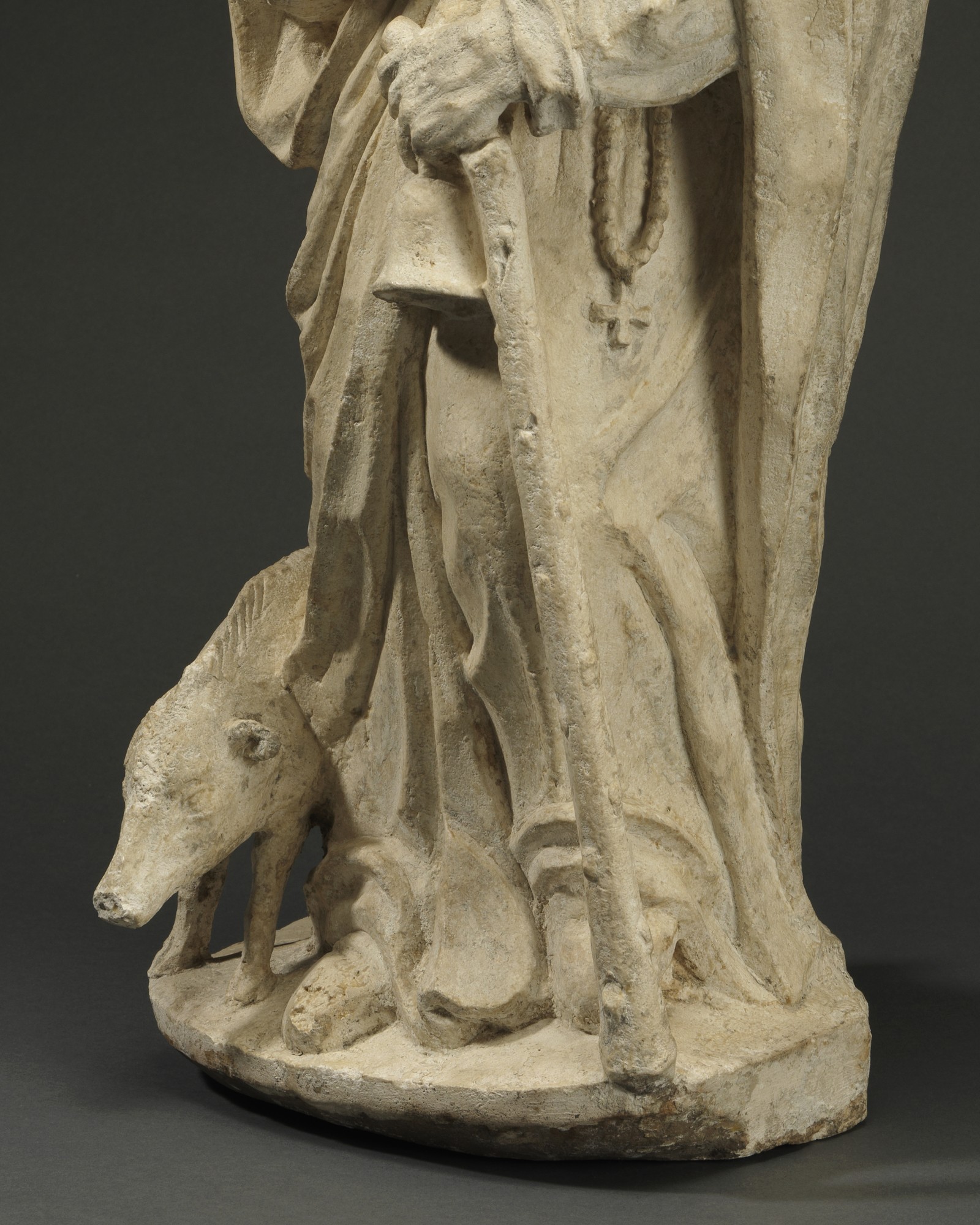


Private collection, Normandy
This beautifully carved limestone sculpture shows Saint Anthony, also known as Anthony the Abbot, Saint Anthony of the Desert, Saint Anthony of Egypt and Saint Anthony the Hermit, dressed in his pilgrim garb, hooded cloak wrapped around his shoulders cascading in deep folds, the ‘T’ symbolising the Tau-cross embroided on the upper left sleeve of his habit, rosary beads hanging from his belt. Immediately identifiable with flowing beard and crown of closely cropped hair, the old abbot holds in his left veined hand the Tau staff, the bell hanging from his finger, the sacred scriptures open in his right hand, the pig, his attribute, by his side. Wide eyed with furrowed brow, creased drawn face, high cheekbones and parted lips, this wonderfully expressive canonical representation of the saint in monastic dress shows fineness in detail reflective of superior skill.
Born into an upper class Christian family near Heraclea, in Upper Egypt, Saint Anthony (c. 261 – c. 356) sold all his possessions, gave the proceeds to the poor and, aged only 20 years, travelled into the desert to lead a life of prayer and contemplation, living in solitude and resisting the temptations of the Devil to a reputed age of 105 years. He spent 15 years studying the lives of other ascetics and practicing their virtues, came to live in a tomb in the Egyptian desert where he was tormented, mentally and physically, by demons that took the shapes of people and wild beasts. At age 35 years Saint Anthony retreated further into the desert, living in complete isolation in an abandoned fort for some 20 further years, seeing no one, talking to no one. Disciples flocked to the fort, however, begging him to come out and act as their spiritual advisor and, in 305, he did emerge spending about five years teaching and organising his followers before retreating again for the remaining 45 years of his life, during which time he did receive visitors and occasionally leave his seclusion in order to help persecuted Christians and to seek out Saint Paul the Hermit.
His long and righteous life was an example which attracted other men to the desert and eventually they formed the first Christian monastic community. The Life of Saint Anthony by Saint Athanasius of Alexandria (298 – 373) spread the saint’s influence and inspired the formation of monastic communities throughout the Christian world. Known as the Father of Monasticism, in 561 Saint Anthony’s relics were transferred to Alexandria and, much later, were claimed by Constantinople. Then, in 980, they were deposited in the Church of La-Motte-Saint-Didier, not far from Vienne, then a Benedictine priory. In 1491 the relics were brought to Arles to the Church of Saint Julian. Today his skull and a leg bone rest in the Church of Saint Trophime in Arles.
In the middle ages, Saint Anthony was the patron of the monastic order the Hospitallers of Saint Anthony founded around 1100 and whose primary vocation was the treatment of diseases of the poor. These monks wore black habits with a blue Tau-cross and in many cities supported their charities by raising pigs. For this reason, the saint is often depicted in the same black habit and with a pig as his attribute. Bells were used to call swine in at the end of the day and to attract alms leading to the adoption of another attribute, a single bell.
The principal symbol of Saint Anthony is the Cross of Tau, named after the Greek letter it resembles and often used as a variant of the Latin or Christian cross. In the present work, the Tau staff is shown as made of wood, the knots of the branch used visible. The loop of the metal bell is around the fingers of the saint rather than suspended from beneath the handle of the staff as is sometimes seen in other representations.
We see in our example the most commonly depicted attribute, a small pig at the saint’s feet, an allusion not only to the animals raised by the Hospitallers, but also to the healing properties of lard in combatting the effects of shingles, known in Italian as ‘Saint Anthony’s fire’. The saint was and still is invoked by devotees to combat infectious disease, particularly skin disease such as eczema, ergotism, erysipelas, as well as shingles.
Beneath the heavy drape of the cassock and woollen cloak, the stance of the old abbot is both natural and elegant, his right arm bent holding the word of God, a placid soothing gesture, the left leg is pushed forward, bent, wrist cocked his left hand leaning on the handle of the staff, the composition perfectly balanced to evoke an overall sense of tranquillity and serenity. The artist has captured the concentration of a man venerated for a life time’s devotion to moral thought and, at the same time, his inherent humanity and kind, protective and caring character.
The stylistic characteristics of this sculpture point to a master craftsman working at high level in Normandy at the end of the 15th century. The object is in a remarkable state of preservation.
SOLD: Norwich Castle Museum and Art Gallery